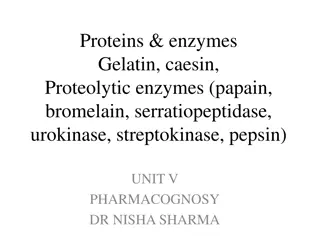Understanding Chemical Reactions and Enzymes
Chemical reactions involve the transformation of chemicals by breaking and forming chemical bonds. Energy is released or absorbed during these processes. Reactions that release energy are exothermic, while those that absorb energy are endothermic. Catalysts help speed up reactions by lowering the activation energy required for them to proceed.
Download Presentation

Please find below an Image/Link to download the presentation.
The content on the website is provided AS IS for your information and personal use only. It may not be sold, licensed, or shared on other websites without obtaining consent from the author. Download presentation by click this link. If you encounter any issues during the download, it is possible that the publisher has removed the file from their server.
E N D
Presentation Transcript
2.4 Chemical Reactions and Enzymes
Chemical Reactions A chemical reaction is a process that changes, or transforms, one set of chemicals into another by changing the chemical bonds that join atoms in compounds. @Mass and energy are conserved during chemical transformations.@ The elements or compounds that enter into a chemical reaction are known as reactants. The elements or compounds produced by a chemical reaction are known as products.
Chemical Reactions As it enters the blood, carbon dioxide (CO2) reacts with water to produce carbonic acid (H2CO3), which is highly soluble. This chemical reaction enables the blood to carry carbon dioxide to the lungs. In the lungs, the reaction is reversed and produces carbon dioxide gas, which you exhale.
What is released or absorbed whenever chemical bonds form or are broken?
Energy Changes @Energy is released or absorbed whenever chemical bonds are formed or broken during chemical reactions.@ Chemical reactions that release energy often occur on their own, or spontaneously. Chemical reactions that absorb energy will not occur without a source of energy.
Exothermic Reactions 7 @Reaction in which heat is given off is exothermic@(Ex. combustion of fuels)
Endothermic Reactions 8 @Reaction in which heat is absorbed is endothermic@ (Ex. water is evaporated)
Chemists call the energy needed to get a reaction started the . activation energy
Activation Energy 10 Energy needed to get a reaction going is the activation energy.
What is a catalyst? A catalyst is a substance that speeds up the rate of a chemical reaction. @Catalysts work by lowering a reaction s activation energy.@
The Enzyme-Substrate Complex The substrates bind to a site on the enzyme called the active site. The active site and the substrates have complementary shapes. The fit is so precise that the active site and substrates are often compared to a lock and key.
Regulation of Enzyme Activity Temperature, pH, and regulatory molecules are all factors that can affect the activity of enzymes on or off as needed.























